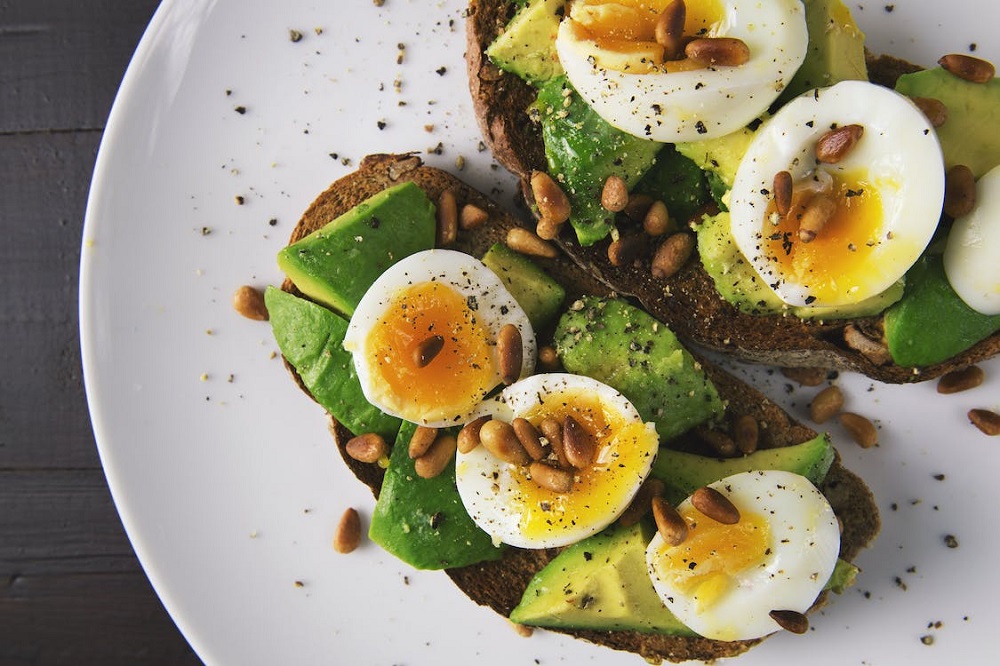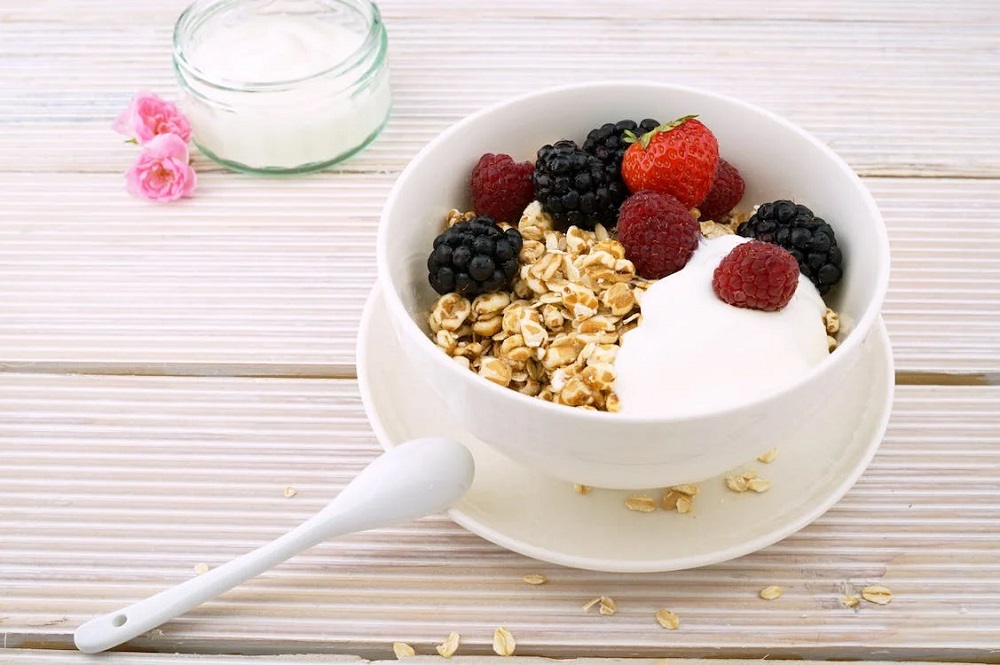Creating a Healthy Plate for a Balanced Diet

A healthy plate of food provides the body with the essential nutrients it needs to function at its best. In this article, we will explore the components of a well-balanced and nutritious meal.
The Ideal Macronutrient Composition
A healthy plate of food starts with the right balance of macronutrients. The ideal composition is approximately 50% carbohydrates, 25% protein, and 25% healthy fats. This balance ensures that you receive the necessary energy and nutrients.
Carbohydrates are the body’s primary energy source. They can be found in foods like grains, fruits, and vegetables. It’s essential to choose complex carbohydrates, such as whole grains, over simple sugars, as they provide sustained energy and prevent blood sugar spikes.
Proteins are the building blocks of our body. They support muscle growth and repair. Lean protein sources like chicken, fish, tofu, and legumes are excellent choices. They are low in saturated fats, making them heart-healthy options.
Healthy fats, which can be found in avocados, nuts, and olive oil, are necessary for brain function and overall health. They should be consumed in moderation but are an important part of a balanced diet. These fats provide essential fatty acids that the body cannot produce on its own.
Nutrient-Rich Foods
To create a healthy plate, it’s essential to focus on nutrient-rich foods. These foods are packed with vitamins, minerals, and antioxidants. Incorporate plenty of fruits, vegetables, and whole grains into your meals. They are not only nutritious but also low in calories.
Fruits and vegetables should form a significant part of your plate. They are rich in vitamins, minerals, and dietary fiber. Aim for a variety of colors to ensure you receive a broad spectrum of nutrients. For example, dark leafy greens like spinach and kale are rich in vitamins A and K, while orange vegetables like carrots and sweet potatoes provide a healthy dose of vitamin C and beta-carotene.
Whole grains, such as brown rice, quinoa, and whole wheat bread, offer complex carbohydrates and dietary fiber. They provide sustained energy and promote digestive health. Whole grains contain more nutrients than their refined counterparts and are less processed, making them a healthier choice.
Portion Control
Portion control is a critical aspect of maintaining a healthy plate. Eating the right amount of food helps prevent overconsumption and aids in weight management. Using smaller plates can be a helpful trick to control portions. Additionally, be mindful of serving sizes by reading food labels and using measuring cups.
Balancing portion sizes is particularly important when considering different food groups. For example, aim to fill half your plate with fruits and vegetables, one-quarter with lean protein, and one-quarter with whole grains. This guideline ensures that you’re not overloading on one type of food while neglecting others.
Fruits and Vegetables
Fruits and vegetables should be at the heart of your healthy plate. They are not only rich in essential vitamins and minerals but also provide dietary fiber, which aids in digestion and helps you feel full. When including these in your diet, diversity is key.
Consider incorporating a range of colorful fruits and vegetables to maximize the nutritional benefits. For instance, dark leafy greens like spinach and kale are rich in iron and calcium, while berries are packed with antioxidants. Remember that fruits and vegetables can be enjoyed fresh, frozen, or canned (without added sugars or salt) to accommodate your preferences and budget.
Lean Proteins
Incorporating lean proteins into your diet is essential for muscle growth and repair. These proteins are not only low in saturated fats but also provide high-quality amino acids that support various bodily functions. Examples of lean protein sources include chicken, turkey, fish, tofu, legumes, and low-fat dairy products.
When choosing meat, opt for lean cuts and consider cooking methods that minimize added fats. Grilling, baking, broiling, or steaming are healthier alternatives to frying. For vegetarians or those looking to reduce their meat consumption, plant-based sources like tofu, tempeh, and legumes are excellent options.
Whole Grains
Whole grains, such as brown rice, quinoa, and whole wheat bread, offer complex carbohydrates and dietary fiber. They provide sustained energy and promote digestive health. Whole grains contain more nutrients than their refined counterparts and are less processed, making them a healthier choice.
When selecting grains for your plate, consider whole-grain alternatives like whole wheat pasta, quinoa, and brown rice. These choices are not only more nutritious but also have a nuttier, more robust flavor that can enhance the overall taste of your meals.
Healthy Fats
Healthy fats, such as those found in avocados, nuts, and olive oil, are necessary for brain function and overall health. They should be consumed in moderation but are an important part of a balanced diet. These fats provide essential fatty acids that the body cannot produce on its own.
Avocado is an excellent source of monounsaturated fats and is rich in nutrients like potassium and folate. Nuts, such as almonds and walnuts, are packed with heart-healthy fats and provide protein and fiber. Olive oil, especially extra virgin olive oil, is a staple in the Mediterranean diet and is known for its numerous health benefits.
Hydration
Don’t forget about hydration. Water is an essential component of a healthy plate. Aim to drink plenty of water throughout the day to stay well-hydrated. Water not only supports bodily functions but also helps control appetite and may prevent overeating.
Staying hydrated is particularly important when consuming fiber-rich foods, as water aids in the digestive process. While other beverages like herbal teas or infused water can contribute to your daily fluid intake, pure water should be the primary source of hydration. It’s calorie-free and has no added sugars or artificial ingredients.
Balancing Calories
Balancing calories is vital for weight management. Be mindful of the calories you consume and expend. A calorie deficit can help with weight loss, while a calorie surplus may lead to weight gain. Understanding your daily caloric needs and managing your food intake accordingly is crucial.
To create a calorie deficit, you can combine a balanced diet with regular physical activity. Keep in mind that it’s not just about reducing calories but also making nutritious choices. Consuming whole, nutrient-dense foods that are low in empty calories is the most effective way to balance your calorie intake.
Dietary Fiber
Fiber is crucial for digestive health. It helps with regular bowel movements and can aid in weight management. Foods rich in fiber include whole grains, fruits, and vegetables. When it comes to dietary fiber, there are two main types: soluble and insoluble.
Soluble fiber, found in foods like oats, apples, and beans, can help lower cholesterol levels and regulate blood sugar. Insoluble fiber, present in wheat bran, nuts, and vegetables like broccoli, adds bulk to the stool and aids in regular bowel movements. Both types are essential for overall digestive health.
Avoiding Processed Foods
Processed foods are often high in added sugars, unhealthy fats, and sodium. They should be limited in a healthy diet. Opt for whole, unprocessed foods whenever possible. The term “processed foods” encompasses a wide range of products, from minimally processed items like frozen vegetables to heavily processed and ultra-processed products such as sugary cereals and fast food.
When shopping, check ingredient labels and nutrition facts to identify added sugars, trans fats, and excessive sodium levels. Reducing your consumption of processed foods can significantly improve the overall quality of your diet.
Meal Planning Tips
Effective meal planning can make it easier to create healthy plates. Plan your meals in advance and consider your nutritional needs. This can help you make better food choices. Here are some practical meal planning tips to consider:
- Set Goals: Determine your dietary goals, whether it’s weight management, improved nutrition, or trying new recipes.
- Create a Weekly Menu: Plan your meals for the week, including breakfast, lunch, dinner, and snacks. Make sure to include a variety of food groups.
- Make a Shopping List: Based on your menu, create a shopping list to ensure you have all the necessary ingredients.
- Prep Ingredients: Spend time prepping ingredients in advance. Wash, chop, and store fruits and vegetables, cook grains, and prepare proteins. This saves time during the week.
- Cook in Batches: Cook larger portions of meals and freeze individual servings for quick and healthy options on busy days.
- Try New Recipes: Experiment with new recipes and ingredients to keep your meals interesting and diverse.
The Importance of Variety
Variety in your diet ensures that you receive a wide range of nutrients. Avoid eating the same foods every day. Experiment with different ingredients and cuisines to keep your meals exciting and nutritious.
Incorporating a variety of foods into your diet not only provides a wide spectrum of nutrients but also keeps your meals interesting and enjoyable. It can prevent dietary monotony and reduce the risk of nutrient deficiencies. To introduce variety:
- Explore international cuisines and try new recipes.
- Shop at local markets for fresh and seasonal produce.
- Incorporate different protein sources like fish, poultry, beans, and tofu.
- Rotate grains and starches, such as quinoa, brown rice, and sweet potatoes.
Conclusion
In conclusion, a healthy plate of food should be a well-balanced mix of macronutrients, with a focus on nutrient-rich foods like fruits, vegetables, lean proteins, whole grains, and healthy fats. Portion control, hydration, and balanced calorie intake are essential for maintaining your health. By avoiding processed foods, planning your meals, and embracing variety, you can create a plate that promotes your overall well-being.
Frequently Asked Questions (FAQs)
How can I create a healthy plate of food on a budget?
Creating a healthy plate on a budget is possible by prioritizing affordable, nutrient-dense foods like beans, lentils, and frozen fruits and vegetables. Look for sales, discounts, and coupons to save money on healthy choices.
Are there any specific portion sizes I should follow for a healthy plate?
Portion sizes can vary based on individual needs, but a general guideline is to fill half your plate with vegetables, one-quarter with lean protein, and one-quarter with whole grains. Adjust portion sizes to fit your activity level and dietary requirements.
Can I still enjoy my favorite treats while maintaining a healthy plate?
Yes, indulging in your favorite treats occasionally is perfectly fine. The key is moderation and balance. Treats can be part of a healthy diet as long as they are not consumed in excess.
How can I stay motivated to eat a healthy plate of food consistently?
Set realistic goals, track your progress, and involve friends or family in your journey. This can help you stay motivated. Consider keeping a food diary or using apps to monitor your meals and nutrition.
What are some simple meal planning strategies for a healthy plate?
Meal planning involves creating a weekly menu, making a shopping list, and prepping ingredients in advance. It helps you make better food choices and reduce food waste. Experiment with new recipes and incorporate seasonal ingredients to keep your meals exciting and nutritious.








